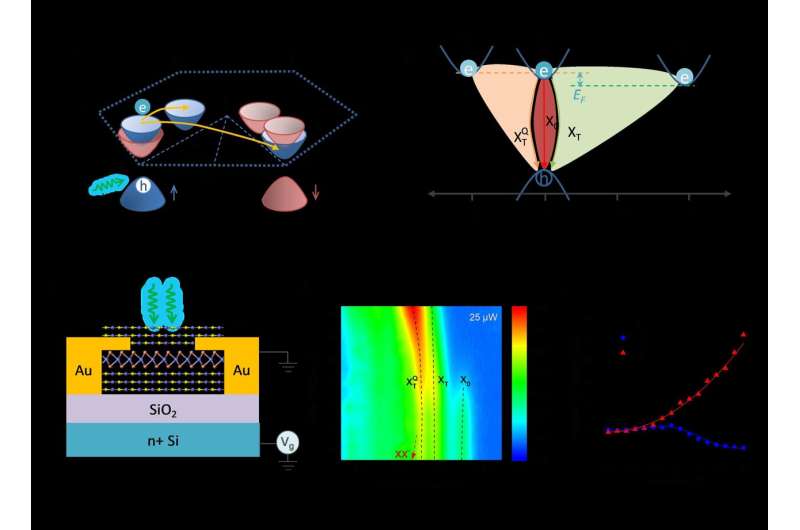Switching of K-Q intervalley trions fine structure and their dynamics in n-doped monolayer WS2

Drawing on the research idea of electron spin degree of freedom, the valley degree of freedom can be used as an information carrier to design and realize related functional devices. Monolayer group VI transition metal dichalcogenides (TMDs) have recently emerged as promising candidates for photonic and opto-valleytronic applications due to their excellent photoelectric properties and peculiar energy valley structure.
On the other hand, the optoelectronic properties of these atomically-thin semiconducting crystals are strongly governed by the tightly bound electron-hole pairs such as excitons and trions (charged excitons) as a result of the enhanced Coulomb interactions in the 2D limit. The anomalous spin and valley configurations at the conduction band edges in monolayer WS2 give rise to even more fascinating valley many-body complexes.
The coupling of charges, spins, energy valleys, and many-body complex quasiparticles offers opportunities to manipulate quantum information by an optical method. Among them, the control of these many-body complexes by regulating the valley charge by external fields is an effective means to realize the development of novel quantum devices, which is expected to be applied in the fields of quantum computing and quantum communication.
The authors of an article now published in Opto-Electronic Advances found that the indirect Q valley in the first Brillouin zone of monolayer WS2 plays a critical role in the formation of a new excitonic state. By employing a high-quality h-BN encapsulated WS2 field-effect transistor, it is able to switch the electron concentration within K-Q valleys at conduction band edges. Consequently, a distinct emission feature could be excited at the high electron doping region. This feature is competitive with the traditional K-valley trions and obeys the Boltzmann distribution law.
Further studies have proved that this feature is from the luminescence of the indirect Q-valley trions. Such a feature differs from the previously reported trion-exciton complex (XX-), which only appeared at the very low doping region of the sample, although they have very close energies. It is found that the actual doping level of the sample has a significant impact on the power-law response of this emission feature. With increasing Fermi level, the scattering of electrons to the Q valley becomes more efficient facilitating the formation of such a charged state. Consequently, it is able to tune its power-law response from linear (α~0.95) to superlinear (α~1.42), and radiative lifetime τ2 from 880 ps to 250 ps efficiently by gate modulation.
The study suggests that the indirect Q valley has a significant impact on the relaxation pathways of exciton complexes when its energy level is lower or close to that of the direct K valley, which provides a new perspective for understanding the material. The authors also note that the Q valley at the first Brillouin zone results from the strong hybridization of p- and d-orbitals between the chalcogen atom X and the transition metal atom M, which makes these valleys highly sensitive to the environmental stimulus, such as the strain, doping, magnetic field, dielectric field, etc. The strong Q-K valley interaction suggests that such states are good candidates for tuning the spin/valley entanglement in these materials and their heterostructures.
These findings open up a new avenue for the study of valley many-body physics and quantum optics in semiconducting 2D materials, as well as provide a promising way of valley manipulation for next-generation entangled photonic devices.
More information: Jiajie Pei et al, Switching of K-Q intervalley trions fine structure and their dynamics in n-doped monolayer WS2, Opto-Electronic Advances (2022). DOI: 10.29026/oea.2023.220034
Provided by Compuscript Ltd




















